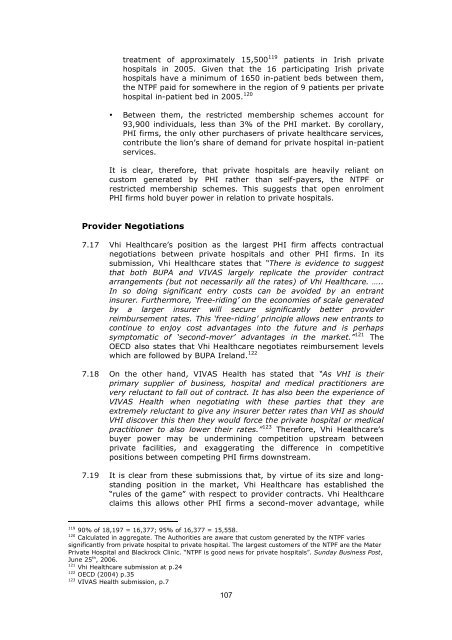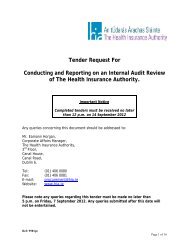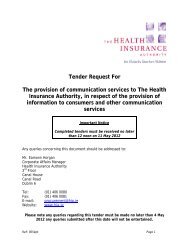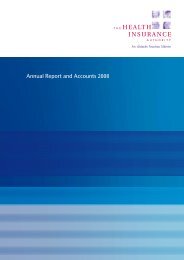Competition in the Irish Private Health Insurance Market
Competition in the Irish Private Health Insurance Market
Competition in the Irish Private Health Insurance Market
You also want an ePaper? Increase the reach of your titles
YUMPU automatically turns print PDFs into web optimized ePapers that Google loves.
treatment of approximately 15,500 119 patients <strong>in</strong> <strong>Irish</strong> private<br />
hospitals <strong>in</strong> 2005. Given that <strong>the</strong> 16 participat<strong>in</strong>g <strong>Irish</strong> private<br />
hospitals have a m<strong>in</strong>imum of 1650 <strong>in</strong>-patient beds between <strong>the</strong>m,<br />
<strong>the</strong> NTPF paid for somewhere <strong>in</strong> <strong>the</strong> region of 9 patients per private<br />
hospital <strong>in</strong>-patient bed <strong>in</strong> 2005. 120<br />
• Between <strong>the</strong>m, <strong>the</strong> restricted membership schemes account for<br />
93,900 <strong>in</strong>dividuals, less than 3% of <strong>the</strong> PHI market. By corollary,<br />
PHI firms, <strong>the</strong> only o<strong>the</strong>r purchasers of private healthcare services,<br />
contribute <strong>the</strong> lion’s share of demand for private hospital <strong>in</strong>-patient<br />
services.<br />
It is clear, <strong>the</strong>refore, that private hospitals are heavily reliant on<br />
custom generated by PHI ra<strong>the</strong>r than self-payers, <strong>the</strong> NTPF or<br />
restricted membership schemes. This suggests that open enrolment<br />
PHI firms hold buyer power <strong>in</strong> relation to private hospitals.<br />
Provider Negotiations<br />
7.17 Vhi <strong>Health</strong>care’s position as <strong>the</strong> largest PHI firm affects contractual<br />
negotiations between private hospitals and o<strong>the</strong>r PHI firms. In its<br />
submission, Vhi <strong>Health</strong>care states that “There is evidence to suggest<br />
that both BUPA and VIVAS largely replicate <strong>the</strong> provider contract<br />
arrangements (but not necessarily all <strong>the</strong> rates) of Vhi <strong>Health</strong>care. …..<br />
In so do<strong>in</strong>g significant entry costs can be avoided by an entrant<br />
<strong>in</strong>surer. Fur<strong>the</strong>rmore, ‘free-rid<strong>in</strong>g’ on <strong>the</strong> economies of scale generated<br />
by a larger <strong>in</strong>surer will secure significantly better provider<br />
reimbursement rates. This ‘free-rid<strong>in</strong>g’ pr<strong>in</strong>ciple allows new entrants to<br />
cont<strong>in</strong>ue to enjoy cost advantages <strong>in</strong>to <strong>the</strong> future and is perhaps<br />
symptomatic of ‘second-mover’ advantages <strong>in</strong> <strong>the</strong> market.” 121 The<br />
OECD also states that Vhi <strong>Health</strong>care negotiates reimbursement levels<br />
which are followed by BUPA Ireland. 122<br />
7.18 On <strong>the</strong> o<strong>the</strong>r hand, VIVAS <strong>Health</strong> has stated that “As VHI is <strong>the</strong>ir<br />
primary supplier of bus<strong>in</strong>ess, hospital and medical practitioners are<br />
very reluctant to fall out of contract. It has also been <strong>the</strong> experience of<br />
VIVAS <strong>Health</strong> when negotiat<strong>in</strong>g with <strong>the</strong>se parties that <strong>the</strong>y are<br />
extremely reluctant to give any <strong>in</strong>surer better rates than VHI as should<br />
VHI discover this <strong>the</strong>n <strong>the</strong>y would force <strong>the</strong> private hospital or medical<br />
practitioner to also lower <strong>the</strong>ir rates.” 123 Therefore, Vhi <strong>Health</strong>care’s<br />
buyer power may be underm<strong>in</strong><strong>in</strong>g competition upstream between<br />
private facilities, and exaggerat<strong>in</strong>g <strong>the</strong> difference <strong>in</strong> competitive<br />
positions between compet<strong>in</strong>g PHI firms downstream.<br />
7.19 It is clear from <strong>the</strong>se submissions that, by virtue of its size and longstand<strong>in</strong>g<br />
position <strong>in</strong> <strong>the</strong> market, Vhi <strong>Health</strong>care has established <strong>the</strong><br />
“rules of <strong>the</strong> game” with respect to provider contracts. Vhi <strong>Health</strong>care<br />
claims this allows o<strong>the</strong>r PHI firms a second-mover advantage, while<br />
119 90% of 18,197 = 16,377; 95% of 16,377 = 15,558.<br />
120 Calculated <strong>in</strong> aggregate. The Authorities are aware that custom generated by <strong>the</strong> NTPF varies<br />
significantly from private hospital to private hospital. The largest customers of <strong>the</strong> NTPF are <strong>the</strong> Mater<br />
<strong>Private</strong> Hospital and Blackrock Cl<strong>in</strong>ic. “NTPF is good news for private hospitals”. Sunday Bus<strong>in</strong>ess Post,<br />
June 25 th , 2006.<br />
121 Vhi <strong>Health</strong>care submission at p.24<br />
122 OECD (2004) p.35<br />
123 VIVAS <strong>Health</strong> submission, p.7<br />
107







